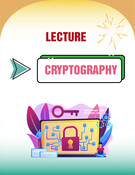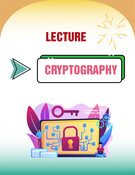XML Security
Pag. 1
Outline
• Security requirements for web data. • Basic concepts of XML • Security policies for XML data protection
and release
• Access control mechanisms for XML data • XMLbased specification of security
informaiton
• XML security: future trends
Pag. 2
Web Data: Protection Requirements
• The web is becoming the main informaiton
dissemination means for many organizations
• Strong need for models and mechanisms
enabling the specification and enforcement of security policies for web data protection and release
Pag. 3
Web Data
•
In the web environment, information distribution often takes the form of documents that are made available at Web servers, or that are actively broadcasted by Web servers to interested clients • Documents may also be exchanged
among the various servers
Pag. 4
Web Docs: Protection Requirements
• Web documents may have a nested or hierarchical, interlinked structure
• Different portions of the same document
may have different protection requirements
We need a wide spectrum of protection
granularity levels
Pag. 5
Web Docs: Protection Requirements
• Web documents may have an associated
description of their structure: – DTDs and XML Schemas for XML documents – Data models for describing the logical organization of data into web pages
Policies specified both at the schema and at the instance level
Pag. 6
Web Docs: Protection Requirements
• Documents with the same type and
structure may have contents of different sensitivity degree:
Policies that take the document content into account (contentbased policies)
Pag. 7
Web Docs: Protection Requirements
•
Supporting finegrained policies could lead to the specification of a, possibly high, number of access control policies:
Need of mechanisms for exception management and authorization propagation
Pag. 8
Web Docs: Protection Requirements
• Heterogeneity of subjects:
–
Subjects accessing a web source may be characterized by different skills and needs and may dynamically change
– Conventional identitybased access control
schemes are not enough
Credentials based on subject
characteristics
and qualifications
Pag. 9
Web Docs: Protection Requirements
•
In a web environment the traditional on userdemand mode of performing access control is not enough:
Security policies enforcing both the pull
and push dissemination modes
Pag. 10
Dissemination Policies
Request
• PULL
View
Web Data Source
• PUSH
Pag. 11
Web Data Source
Outline
• Security requirements for web data • Basic concepts of XML • Security policies for XML data protection
and release
• Access control mechanisms for XML data • XMLbased specification of security
information
• XML security: future trends
Pag. 12
Why XML?
• Because XML is becoming a standard for
data representation over the web
• XML compatibility is thus an important
requirement for security policies, models and mechanisms for Web data sources
Pag. 13
XML
• Building blocks of XML are tagged elements
that can be nested at any depth in the document structure
• Each tagged element has zero or more
subelements and zero or more attributes
• Elements can be linked by means of IDREF(S)
attributes
• Optional presence of a DTD/XMLSchema for describing the structure of documents (well formed vs valid documents)
Pag. 14
An XML Document
Graph Representation
WordLawBulletin
{(Date,”08/08/1999”)}
Law
BluePageReport
Law
{(Country,”USA”)}
{(Country,”Italy”)}
RelatedLaws
LK75
&1
Summary
Section
Section
Topic
Summary
Topic
{(GeoArea,”NorthA.”)}
{(GeoArea,E.)} &8
&2 &7
Law
Law
ImportExport
Taxation
...
{(Country,”Germany”)}
{(Country,”USA”)}
&3 &4 &5 &6 &9
Summary
Topic
Summary
Topic
&13 &10
Guns
Transportation
Pag. 16
&11 &12 &14 &15
An XML DTD
Country CDATA #REQUIRED RelatedLaws IDREFS #IMPLIED>
]>
XML & Security
Two main issues:
1. Development of access control models,
techniques, mechanisms, and systems for protecting XML documents
2. Use of XML to specify security relevant information, (organizational policies, subject credentials, authentication information, encrypted contents)
Pag. 18
The Author-X Project
Pag. 19
AuthorX
• Javabased system for XML data sources
protection
• Security policy design and administration • Credentialbased access control to XML
document sources
• Secure document dissemination and update
Pag. 20
AuthorX ACPs
• Setoriented and documentoriented policies • Positive and negative policies at different
granularity levels, to enforce differentiated protection of XML documents and DTDs
• Controlled propagation of access rights • ACPs reflect user profiles through credential
based qualifications
Pag. 21
Enforcing access control
• Subject specification • Protection object specification • Privilege • Propagation option
Pag. 22
Subject Specification
• User Identifiers
OR • Subject credential: credential expression
Ex: X.age > 21
Programmer(X) and
X.country=“Italy”
Pag. 23
Protection Object Specification
•
Identify the portions of a document(s) to which the authorization applies.
We want to allow users to specify authorizations
ranging from
– sets of documents – to single elements/attributes within documents
specification on DTD or documents [{doc|*}|{DTD|#}].[pathOfElem|ElemIds].[Attrs|links]
Pag. 24
Privileges
read
• browsing
navigate
write
• authoring
append
delete
Pag. 25
Propagation option
NO PROPAGATION
Pag. 26
Propagation option
FIRST LEVEL
Pag. 27
Propagation option
CASCADE
Pag. 28
Examples of authorization rules
P1 = ((LLoC Employee or European Division Employee), WorldLawBulletin.Law, browse_all, *)
this authorization rule authorizes the LLoC and European Division Employees to view all laws (not contained in the BluePageReport element) in all instances of WorldLawBulletin relations among laws, that is, RelatedLaws attributes, are also displayed
Pag. 29
Examples of authorization rules
P4 = (European Division Employee,
(WorldLawBulletin.BluePageReport.Section,
GeoArea = Europe), browse_all, *)
this authorization rule authorizes the European Division Employees to view the section pertaining to Europe of the BluePageReport in all instances of WorldLawBulletin
Pag. 30
user
SA
access request
view
administrative operations
Author-X
X-Access
X-Admin
DOM/XQL
X-Bases Encrypted doc.base
Credential base
Policy base
Pag. 31
XML Source
XAccess
• The access control component of
AuthorX enabling:
– The enforcement of access control policies on top
of an XML source
– Pull and push dissemination modes
• ClientServer architecture
• Excelon XML server
Pag. 32
Information Pull Architecture
Internet Browser
CLIENT
•
DTD
query
Internet
XML VIEW
Web Server Excelon Server Server Extension (XAccess) XML Parser
XQL
XPath
Excelon File System
SERVER
XML source
Pag. 33
Access Control
Policy base
Credential base
Pruning
Query
XML document
user
XML source
Resulting view
Pruned XML document
Pag. 34
Access request
Target Document
User
Password
query
Pag. 35
Query result
Query result
Pag. 36
Push Dissemination Mode
• Since:
– Different subjects > different views – Wide range of protection granularities – High number of subjects
Number of views can be too large
Solution> Encryption Techniques
Pag. 37
Push Dissemination Mode
• The approach is based on encrypting
different portions of the same document with different keys
• The same (encrypted) copy is then
broadcasted to all subjects
• Each subject only receives the key(s) for
the portions he/she is enabled to see
Pag. 38
Information Push Main Issues
• How to encrypt the documents in a source • Which and how many keys should be
distributed to which subjects
• How to securely and efficiently distribute keys to subjects in such a way that keys are received only by the entitled subjects
Pag. 39
How to Encrypt Documents
• Document encryption is driven by the specified
access control policies: all the document portions to which the same access control policies apply are encrypted with the same key • Thus, to determine which keys should be sent to a particular subject it is only necessary to verify which are the access control policies that apply to that subject and then sending the keys associated with these policies
Pag. 40
WellFormed Encryption
P2
&5
P1,P3
&1
P1,P3
&2 &8
P3
P1,P3
P1,P3
P1,P3
P1,P3
&3 &4 &6 &7 &9 &13
P3
&14 &10
Pag. 41
&11 &12 &15 &16
WellFormed Encryption
P2
Node encrypted with key K1
&5
P1,P3
&1
P1,P3
&2 &8
P3
P1,P3
P1,P3
P1,P3
P1,P3
&3 &4 &6 &7 &9 &13
P3
&14 &10
Pag. 42
&11 &12 &15 &16
WellFormed Encryption
P2
&5
P1,P3
&1
P1,P3
&2 &8
P3
P1,P3
P1,P3
P1,P3
P1,P3
&3 &4 &6 &7 &9 &13
P3
&14 &10
Nodes encrypted with key K2
Pag. 43
&11 &12 &15 &16
WellFormed Encryption
P2
&5
P1,P3
&1
P1,P3
&2 &8
P3
P1,P3
P1,P3
P1,P3
P1,P3
&3 &4 &6 &7 &9 &13
P3
Nodes encrypted with key K3
&14 &10
Pag. 44
&11 &12 &15 &16
WellFormed Encryption
P2
&5
P1,P3
&1
P1,P3
&2 &8
P3
P1,P3
P1,P3
P1,P3
P1,P3
&3 &4 &6 &7 &9 &13
P3
Nodes encrypted with key Kd
&14 &10
Pag. 45
&11 &12 &15 &16
WellFormed Encryption
P2
&5
P1,P3
&1
P1,P3
&2 &8
P3
P1,P3
P1,P3
P1,P3
P1,P3
&3 &4 &6 &7 &9 &13
P3
P1
K2
P2
K1
&14 &10
P3
K2, K3
Pag. 46
&11 &12 &15 &16
Key Management
• Key assignment scheme such that:
– From the key associated with a policy P1 it is
possible to derive the keys associated with all the policy configurations containing P1
• Benefits:
– The system should manage in the worst case a
number of keys equal to the size of the Policy Base – Each subject receives a key for each policy he/she
satisfies
Pag. 47
Key Distribution
• Two modes:
– Online: the XML source delivers both the keys and the encrypted document to subjects
– Offline: subjects retrieve the keys
through further interactions with the XML source (LDAP directory)
Pag. 48
Outline
• Security requirements for web data • Basic concepts of XML • Security policies for XML data protection
and release
• Access control mechanisms for XML data • XMLbased specification of security
information
• XML security: future trends
Pag. 49
Why?
•
•
It allows a uniform protection of XML documents and their securityrelated information It facilitates the export and exchange of security information
Pag. 50
Goals
• Definition of an XMLbased language for specifying securityrelated information for web documents: – Subject credentials – Access control policies for web documents satisfying the previously stated requirements
An example: XSec the XMLbased language developed in the framework of AuthorX
Pag. 51
XSec Credentials
• Credentials with similar structure are
grouped into credential types
• A credential is a set of simple and
composite properties • Credential types DTDs • Credentials
XML documents
Pag. 52
XSec credential type
email?, company)>
cIssuer CDATA #REQUIRED>
]>
XSec credential
XProfiles
• To simplify credential evaluation all the
credentials a subject possesses are collected into an Xprofile
Pag. 55
Xprofile
XSec Policy Specification
• XML template for specifying credential
based access control policies
• The template is as general as possible to be able to model access control policies for a variety of web documents (e.g., HTML, XML)
Pag. 57
XSec Policy Base Template
Pag. 58
]>
Instantiation for XML Sources
Pag. 59
Outline
• Security requirements for web data • Basic concepts of XML • Security policies for XML data protection
and release
• Access control mechanisms for XML data • XMLbased specification of security
information
• XML security: future trends
Pag. 60
Research Trends
• Secure publishing of XML documents:
– A new class of informationcentered applications
based on Data dissemination
– Possible scenarios:
•
•
Information commerce: digital libraries, electronic news Intracompany information systems
• Security requirements:
– Confidentiality – Integrity – Authenticity – Completeness
Pag. 61
Secure Publishing
Traditional Architecture
• The Owner is the producer of
Information Owner
•
•
information It specifies access control policies It answers to subject queries
Subject
Pag. 62
ThirdParty Architecture
Docs
View
• The Publisher is responsible for managing (a portion of) the Owner information and for answering subject queries
Publisher
Owner
Query
• Benefits:
Subscription
• Scalability • No Bottleneck
Subject
Pag. 63
Main References
• B. Dournee, XML Security, RSA Press,
2002.
• E. Bertino, B. Carminati, E. Ferrari, and
B. Thuraisingham, XML Security, AddisonWesley, in preparation.
Pag. 64
Main References
• E. Bertino and E. Ferrari. Secure and Selective
Dissemination of XML Documents, ACM Trans. on Information System and Security, to appear
• E. Bertino, S. Castano, e E. Ferrari. Author X: a
Comprehensive System for Securing XML Documents, IEEE Internet Computing, May 2001
• E. Bertino, S. Castano, e E. Ferrari. Securing XML
Documents: the AuthorX Project Demonstration, Proc. of the ACM SIGMOD Conference 2001
• E. Bertino, S. Castano, E. Ferrari, M. Mesiti. Specifying
and Enforcing Access Control Policies for XML Document Sources. World Wide Web Journal, 3(3), 2000
Pag. 65
Main References
• Web sites:
– The XML Security Page: http://www.nue.etinf.uni
siegen.de/~geuerpollmann/ xml/security.html – OASIS Consortium: http://www.oasisopen.org – World Wide Web Consortium: http://www.w3.org
Pag. 66


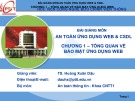

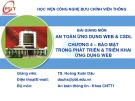
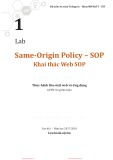
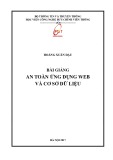
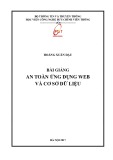
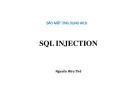
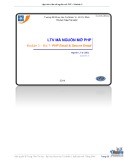

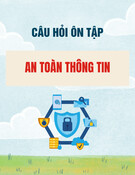

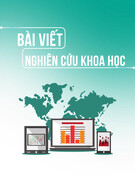
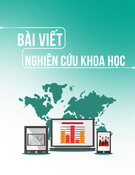
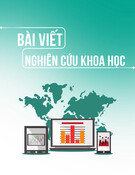




![Câu hỏi ôn tập An toàn mạng [năm hiện tại]](https://cdn.tailieu.vn/images/document/thumbnail/2025/20250702/kimphuong555/135x160/56191751442800.jpg)

![Cẩm nang phòng chống, giảm thiểu rủi ro từ tấn công Ransomware [Mới nhất]](https://cdn.tailieu.vn/images/document/thumbnail/2025/20250627/vijiraiya/135x160/48331751010876.jpg)

